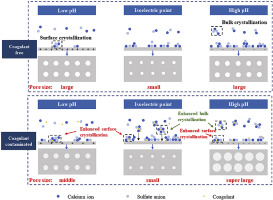Water Research ( IF 12.8 ) Pub Date : 2020-03-07 , DOI: 10.1016/j.watres.2020.115695 Dachao Lin , Langming Bai , Zhendong Gan , Jing Zhao , Guibai Li , Tejraj M. Aminabhavi , Heng Liang

|
Nanofiltration (NF) is extensively applied after coagulation, which is conducive to alleviate organic fouling on NF membranes and improve water purification performance. However, inorganic fouling, which remains the major obstacle to limit the wider application of NF, could be enhanced by even low dosage coagulant. Few researchers realize the existence of coagulant-enhanced scaling, much less control it. This study investigated the effects of pH values on ferric-coagulant-influenced membrane performance during the nanofiltration of brackish water. Both membrane flux behavior (initial membrane flux, normalized flux during filtration, scaling resistance and scaling composition) and ion interception (filtrate conductivity and ions removal) were considered. Solution properties (zeta potential and nanoparticle size) were measured, and coagulant speciation variation was stimulated by Visual MINTEQ software. Mechanisms of ferric-coagulant-influenced membrane performance were analyzed from two aspects on the basis of correlation analyses: interface interaction on membrane surface and salts crystallization process (bulk crystallization and surface crystallization). Results showed that both bulk crystallization in feed solution and surface crystallization on membrane surface were dramatically induced by coagulant. Coagulant-enhanced fouling layer resistance decreased after the initial increase when pH varied from 3.0 to 10.0. Fe(OH)3, a kind of active ingredients in ferric coagulant, was highly responsible for the enhanced scaling layer resistance. Coagulant was found improving ionic removal under acidic conditions despite the fact that it could worsen removal under alkaline conditions. This study is of valuable reference to figure out the mechanisms of coagulant-influenced membrane performance and find a feasible approach to avoid membrane deterioration in coagulant-influenced NF process.
中文翻译:

不同pH值下铁凝剂对石膏结垢和离子拦截效率在纳滤中的作用:性能和机理
混凝后广泛应用纳滤(NF),这有助于减轻NF膜上的有机污垢并改善水净化性能。但是,无机污垢仍然是限制NF广泛应用的主要障碍,即使低剂量的混凝剂也可以增强无机污垢。很少有研究者意识到存在凝结剂增强的水垢,更不用说控制它了。这项研究调查了苦咸水的纳滤过程中pH值对铁-凝结剂影响的膜性能的影响。同时考虑了膜通量行为(初始膜通量,过滤过程中的归一化通量,抗结垢性和结垢成分)和离子截留率(滤液电导率和离子去除)。测量溶液的性质(ζ电位和纳米颗粒尺寸),Visual MINTEQ软件刺激了混凝剂的形态变化。在相关分析的基础上,从两个方面分析了铁血凝剂影响膜性能的机理:膜表面的界面相互作用和盐的结晶过程(本体结晶和表面结晶)。结果表明,凝结剂可显着诱导进料溶液中的大量结晶和膜表面的表面结晶。当pH从3.0变为10.0时,凝结剂增强的污垢层电阻在初始增加后降低。铁(OH)膜表面上的界面相互作用和盐的结晶过程(本体结晶和表面结晶)。结果表明,凝结剂可显着诱导进料溶液中的大量结晶和膜表面的表面结晶。当pH从3.0变为10.0时,凝结剂增强的污垢层电阻在初始增加后降低。铁(OH)膜表面上的界面相互作用和盐的结晶过程(本体结晶和表面结晶)。结果表明,凝结剂可显着诱导进料溶液中的大量结晶和膜表面的表面结晶。当pH从3.0变为10.0时,凝结剂增强的污垢层电阻在初始增加后降低。铁(OH)3,铁凝结剂中的一种有效成分,对增强抗氧化皮性起着高度作用。尽管发现混凝剂可能会使在碱性条件下的去除效果变差,但在酸性条件下仍能改善离子去除效果。这项研究对于弄清楚混凝剂影响的膜性能的机理,并为避免混凝剂影响的NF过程中膜变质找到可行的方法,具有参考价值。



























 京公网安备 11010802027423号
京公网安备 11010802027423号